Design improvements to dribble bar opens way for variable rate application
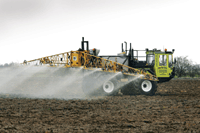
With the new AutoStreamer applicator, Billericay Farm Services believes it has achieved the holy grail of liquid fertiliser application – a “dribble bar” with wide-ranging rate capability that can be adjusted without leaving the tractor cab.
“With conventional dribble bars and nozzles, scope for rate adjustment is limited,” notes BFS general manager, Stephen Kateley. “But with AutoStreamer, operators can go from 60 to 600 litres/ha simply by resetting the sprayer’s rate control system.”
Unlike other dribble bar applicators that regulate flow rate using different inlet orifice sizes, the AutoStreamer’s inlet has a rubber sleeve that allows liquid through only beyond 1 bar pressure. Thereafter, it deflects in line with pressure increases to allow through greater quantities of liquid.
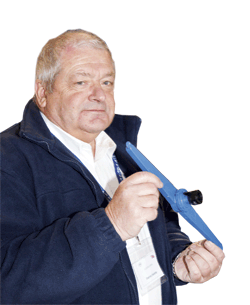 |
|---|
| Stephen Kateley of Billericay Farm Services with the new AutoStreamer dribble bar. Being able to select a wide range of application rates from the tractor seat is a real advance, he says. |
“We proved the concept using water but the real breakthrough came when we found a material with consistent elasticity that’s resistant to all the materials you might find in compound liquid fertilisers,” says Mr Kateley.
Beyond the novel inlet valve, fertiliser passes through individual channels to the four outlets. The main purpose of this design feature was to eliminate starvation of the upper outlets when applying low rates across a slope – an acknowledged shortcoming of the standard hollow-bodied BFS dribble bar.
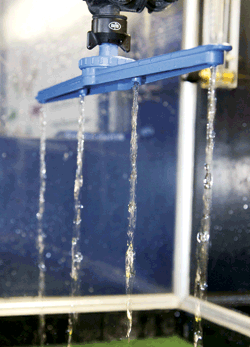 |
|---|
| A flexible rubber sleeve valve in the BFS AutoStreambar’s inlet opens at 1 bar then provides more flow in proportion to increased pressure. |
“But in addition to resolving that issue, we found that having only a small amount of liquid in the applicator means we get virtually instantaneous on-off control,” notes Mr Kateley. “Also, the weight of an AutoStreamer and its contents is about half that of a standard unit, so there is less mass being swung round when a wide boom makes a fast, sweeping turn.”
The key benefit for operators, though, is the ability to make large changes to the application rate without having to change metering discs or compromise working speed.
“With our conventional dribble bar, you can only go from, say, 100 to 170 litres/ha without changing the aperture, so the scope for changing rate from field to field or crop to crop is much more limited,” Mr Kateley points out. “But with the AutoStreamer, operators have enormous scope to select widely differing application rates within a pressure range of 1 to 3 bar – and all at the touch of a button.”
Before this development, BFS and Chafer Machinery came up with ways of dispensing with the flow metering discs that have been used to regulate dribble bar outputs.
Chafer’s Streambar Multi-Rate uses a sliding metering mechanism with six different sized inlet restrictor holes.
“This makes changing application rate a quick and easy process and the range of application rates available is considerably increased,” says Rob Starkey of Chafer Machinery. “With rates up to 1200 litres/ha possible, operators are less likely to need a separate sprayline with closer nozzle spacing to apply very high rates of liquid fertiliser.”
When designing the new Streambar, Chafer engineers also took the opportunity to make several other improvements. The “open chamber” format of earlier bars was replaced by individual feed channels for each of the four outlets to ensure even application when working across slopes.
The Streambar MR is available in 0.5m and 0.33m sizes equipped to fit Chafer or conventional EF3 nozzle bodies, so it can be used on most types of sprayer without needing an adapter.
“It’s an overall more compact design, which minimises the risk of breakages while spraying or travelling on the road,” adds Mr Starkey.
The designers who put together the Billericay Streambar and the Accu-Rate dribble bar, which is now produced by self-propelled sprayer specialist Bateman Engineering, chose a rotary mechanism as an alternative to fitting restrictor discs.
They work simply by lining up one of several different sized flow restrictor holes with the inlet – four in the case of the Accu-Rate, five on the Streambar – so that changing from one rate to another is a quicker and easier process.
Four vertical streams provide complete coverage when they are attached to standard bayonet nozzle bodies at 0.5m spacing and there is also a version of the Accu-Rate for neat installation at boom joints that has a short, three-outlet body plus a “remote” outlet that can be attached to a bracket at the most convenient place for a tidy installation.
While dribble bars remain popular for evenness of application across the boom and good penetration of crop canopy to the ground, improvements in fertiliser nozzle design – together with their inherent advantages – are attracting operators.
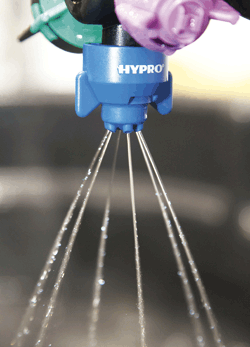 |
|---|
| The Hypro ESI nozzle produces six angled solid jets of liquid fertiliser. |
Development of the Agroco Umbrella nozzle 20 years ago has led to a number of multi-orifice designs from Albuz, Hardi, Lechler and TeeJet, with Hypro EU’s ESI design being the most recent.
They all aim to produce a stream of fertiliser that enters the crop with the biggest droplets possible to get minimal deposition on the leaves, maximum to the ground. With overlapping streams helping to deliver even coverage across the working width, it is important to set boom height correctly.
Different application rates are achieved by selecting the appropriate nozzle size and then fine tuning the output by adjusting the working pressure.
Because nozzles of different sizes can be attached to multi-jet bodies, switching from one rate band to another or changing from liquid fertiliser to pesticide application is relatively easy. Dribble bars must either be removed or used on a second sprayline.
Also, nozzles are less prone than dribble bars to becoming caught on foliage during work and when travelling between fields.
The Hypro ESI is reckoned to be especially compact, projecting only a little further than a conventional spray tip, so is reckoned to be less vulnerable than most to sustaining impact or tangle damage.
It has a FastCap bayonet fitting to suit most standard nozzle holders and comes in six sizes (from 015 to 15) to comfortably handle volumes from 30 to 1000 litres/ha.
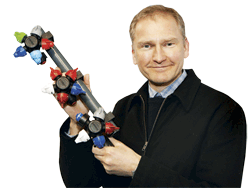 |
|---|
| Roger James of Hypro EU – following up lab work with field observations that produce more versatile application rate and working height recommendations for the ESI nozzle. |
“The ESI is designed to produce six solid streams of liquid fertiliser directed towards the plant base,” says Roger James, Hypro EU product manager. “Conventionally, we recommend operating pressures in the range 1 to 4 bar but recently have been exploring the nozzle’s performance at higher pressures and flow rates as this would increase application rate flexibility.”
There is reasonable scope already for adjusting rate through pressure. At 1 bar, the ESI 08, for example, delivers 160 litres/ha at a brisk 14kph and up to 317 litres/ha at 4 bar.
“But even with our biggest nozzle – the ESI 15 – which delivers 595 litres/ha at 4 bar and 14kph, an operator wanting to put on 1000 litres/ha would have to lose almost half his working speed,” notes Mr James.
Studies commissioned at TAG’s Spray Application Unit, Silsoe, showed that the application pattern from an ESI 06 nozzle, which produces one of the smallest distribution “footprints” of several nozzles compared, changed little across operating pressures from 1 to 6 bar.
“This is by no means a recommendation at this stage; we’re keen to get some field comparisons under our belt first,” Roger James emphasises. “But being able to operate at 6 bar would increase the range of application rates available from individual nozzles quite appreciably – by as much as 300-400 litres/ha.”
TAG scientists at the Silsoe unit also looked at the effect of different boom heights on distribution from the nozzle. With most designs emitting a liquid stream from horizontal or angled outlets this is usually fairly critical if the correct overlap for even coverage is to be achieved.
“But, again, the ‘footprint’ from the ESI nozzle changed little across operating heights from 0.5m to 1m and so we’re keen to evaluate this further in the field,” says Mr James.
While it is logical to recommend positioning the boom 0.5m above the ground since this is the target, doing so in practice is not always possible, nor practicable if it limits travelling speed.
“The Silsoe work showed us that regardless of application method, all fertiliser streams fracture as soon as they hit foliage, which interferes with distribution,” adds Roger James. “This suggests it would be reasonable to position the boom at a more practical distance of 0.5m above the crop, rather than ground, as this is still likely to achieve the most even fertiliser distribution.”
Liquid fertiliser dribble bars and nozzles
Supplier: Agroco
• Product: Umbrella nozzle
• Sizes: Three
• Flow: Three metering discs and pressure
• Output: Seven liquid streams of equal volume in asymmetrical pattern from horizontal outlets.
Supplier: Albuz
• Product: EXA and ESI nozzles
• Sizes: Seven 015 to 06
• Flow: Nozzle size and pressure
• Output: Three (EXA) and six (ESI) vertical angled streams
Supplier: Bateman Engineering
• Product: Accu-Rate dribble bar
• Sizes: 0.5m and 0.33m with remote fourth outlet
• Flow: Four inlet restrictors on rotary selector
• Output: Four vertical streams
Supplier: Billericay Farm Services
• Product: Streamer dribble bar
• Sizes: 0.5m
• Flow: Five inlet restrictors on rotary selector.
• Output: Four vertical streams
Supplier: Billericay Farm Services
• Product: AutoStreamer dribble bar
• Sizes: 0.5m
• Flow: Pressure-related infinitely variable
• Output: Four vertical streams
Supplier: Chafer Machinery
• Product: Streambar MultiRate
• Sizes: 0.5m and 0.33m
• Flow: Six-position restrictor slide
• Output: Four vertical streams
Supplier: Hardi
• Product: Quintastream tip and nozzle
• Sizes: Nine 015 to 15
• Flow: Nozzle size and pressure
• Output: Five vertical streams at different angles and flows
Supplier: Hypro EU
• Product: ESI nozzle
• Sizes: Six 015 to 15
• Flow: Nozzle size and pressure
• Output: Six vertical streams at slight angles
Supplier: Lechler
• Product: FD nozzle
• Sizes: Seven 04 to 20
• Flow: Nozzle size and pressure
• Output: Angled fan
Supplier: Lechler
• Product: FL nozzle
• Sizes: One
• Flow: Five metering discs and pressure
• Output: Five equal streams from horizontal outlets
Supplier: TeeJet
• Product: StreamJet SJ-3 and SJ-7
• Sizes: SJ-3 10 sizes 015 to 20; SJ-7 nine 015 to 15
• Flow: Nozzle size and pressure
• Output: Three and seven equal streams
Note: The Ramsay Trickle Bar is no longer in production but replacement bars and parts are held by Sprayer Spares, Metheringham, Lincs.

